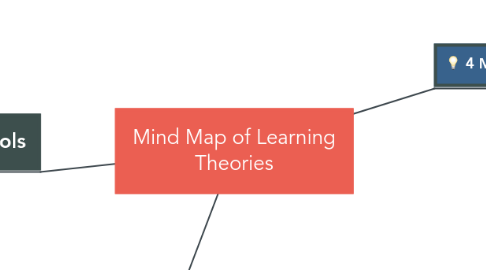
1. Types of Cognitive Tools
1.1. Concept Map
1.1.1. Mind Meister
1.1.2. Inspiration
1.2. Web Development
1.2.1. Front Page
1.2.2. Dreamweaver
1.2.3. Flash
1.3. Presentation
1.3.1. Powerpoint
1.4. Spread Sheet
1.4.1. Excel
1.5. Database
1.5.1. Access
2. Technology on Learning
2.1. Learning From Technology
2.1.1. Instructivist Models
2.1.2. Teacher Centered
2.1.3. R.M. Gange's "Nine Events of Instruction"
2.1.3.1. 1. Gain attention 2. Inform learner of objectives 3. Stimulate recall of prior learning 4. Present stimulus material 5. Provide learner guidance 6. Elicit performance 7. Provide feedback 8. Assess performance 9. Enhance retention transfer
2.1.4. Use of Computer Resources
2.1.5. Use of Intelligent Tutorials Systems
2.1.6. Use of Reusable Learning Objects
2.2. Learning with Technology
2.2.1. Constructivist Models
2.2.2. Use of Interactive Learning Objects
2.2.3. Use of Cognitive Tools
2.2.4. Inquiries and Problems Solving Approach
2.2.5. Student Centered Learning Environments
2.2.6. Use of Online Collaboration Technology to build up knowledge
2.2.7. Use of WebQuest and ActiveLesson Approaches
3. 4 Major Learning Theories
3.1. Behavorism
3.1.1. Characteristics
3.1.1.1. Stimulus & Response Theory
3.1.1.2. Learning is a connection between stimulus & response
3.1.1.3. Focus on cause & effect relationship
3.1.1.4. Teachers gives students stimuli & feedback
3.1.1.5. No transfer of learning to other areas
3.1.1.6. Drill & practice approach
3.1.2. Behaviorists
3.1.2.1. E.L. Thorndike
3.1.2.1.1. Propose Stimulus-Responce theory
3.1.2.1.2. Connections of stimuli & responses form learning
3.1.2.1.3. "Law and Effect" Positive rewards strengthen the connection between stimuli & responses
3.1.2.2. B.F. Skinner
3.1.2.2.1. Emphasized reward (reinforcement)
3.1.2.2.2. Extended to Stimulus --> Response --> Reinforcement Theory
3.1.2.2.3. "Skinner Box" experiment Inside a box, if a lever was pressed then food came out. Through several trials, a rat learned to press the level to get food
3.1.3. Criticisms
3.1.3.1. Not all learning is behavioristic
3.1.3.2. Mind thinkings & processes are not important
3.1.3.3. Cannot explain mind learning activities
3.2. Cognitivism
3.2.1. Characteristics
3.2.1.1. Knowledge construct mentally in mind as an information processor
3.2.1.2. It is a mind representation and mental models
3.2.1.3. Mental processes of how to think, perceive, remember and learn knowledges
3.2.1.4. Use cognitive strategies to transfer knowledges
3.2.1.5. There are short-term, long-term and working memory in human brain
3.2.1.6. Students remember ways of thinking (rules, patterns & strategies)
3.2.1.7. Thinking is mind manipulation & representations
3.2.2. Cognitive Psychologist
3.2.2.1. J.S. Burner
3.2.2.1.1. Learners understand fundamental knowledge structures
3.2.2.1.2. Learners generalize knowledge and apply to similar situations
3.2.2.1.3. Transfer of knowledge is possible
3.2.2.1.4. Knowledges placed into structural frameworks is retended better
3.2.2.1.5. 3 models of knowledge presentation: Enactive, Iconic & Symbolic
3.2.2.2. L.S. Vygotsky
3.2.2.2.1. Emphasized the importance of socio-cultural factors in education
3.2.2.2.2. Concerned the inter-relationship of language development and thought
3.2.2.2.3. Development takes place if social environment changes
3.2.2.2.4. Cooperative arrangement fosters learning
3.2.2.2.5. Teaching is structured to students' self-learning
3.2.2.3. J. Piaget
3.2.2.3.1. Piaget's theory of cognitive development
3.2.2.4. Implications
3.2.2.4.1. Discovery learning
3.2.2.4.2. Spiral curriculum
3.3. Constructivism
3.3.1. Characteristics
3.3.1.1. All knowledge is actively constructed by learners
3.3.1.2. Knowledge is not passively received
3.3.1.3. Learning involved personal discoveries
3.3.1.4. An adaptive process to learn: Collect ideas --> Use ideas --> Construct own knowledge
3.3.1.5. Construct knowledge through assimilation & accommodation
3.3.1.6. Use existing knowledge to build new knowledge
3.3.1.7. Cognitive constructivism--> social constructivism
3.3.2. Constructivists
3.3.2.1. L.S. Vygotsky
3.3.2.1.1. Knowledge direct to further cognitive development
3.3.2.1.2. Culture is the main determinant of cognitive development
3.3.2.1.3. Stress on actual mechanism of development
3.3.2.1.4. Knowledge is internalized by social activities (eg. mediation)
3.3.2.2. J. Piaget
3.3.2.2.1. Introduce the constructivist theory of knowing
3.3.2.2.2. Interact with environment, knowledge is established and mentally constructed
3.3.2.2.3. Interested in epistemology
3.3.2.2.4. Piaget's cognitive-developmental theories
3.3.3. Implications
3.3.3.1. Reject traditional teacher dominant teaching methods
3.3.3.2. Social interaction between teachers & students
3.3.3.3. Constructivist teachers give directions to guide students to discuss
3.3.3.4. By classroom discussion, students gain the skills of knowledge construction
3.3.3.5. Create a classroom environment for students to construct knowledge under individual social basis
3.3.3.6. Develop students' creative thinking
3.4. Communication
3.4.1. Characterisitics
3.4.1.1. Learning is a communication process
3.4.1.2. The teacher transfers knowledge to the student
3.4.1.3. Learning is said to have taken place when the student demonstrates that he/she understood what was communicated
3.4.2. Affected by factors:
3.4.2.1. Environmental: loud noise, poor lighting, uncomfortable temperatures, excessive movement
3.4.2.2. Psychological: represents students' individual psychological differences, including their emotional state & learning styles
3.4.2.3. Personal filters: include teachers' & students' cultural heritage, values and beliefs

